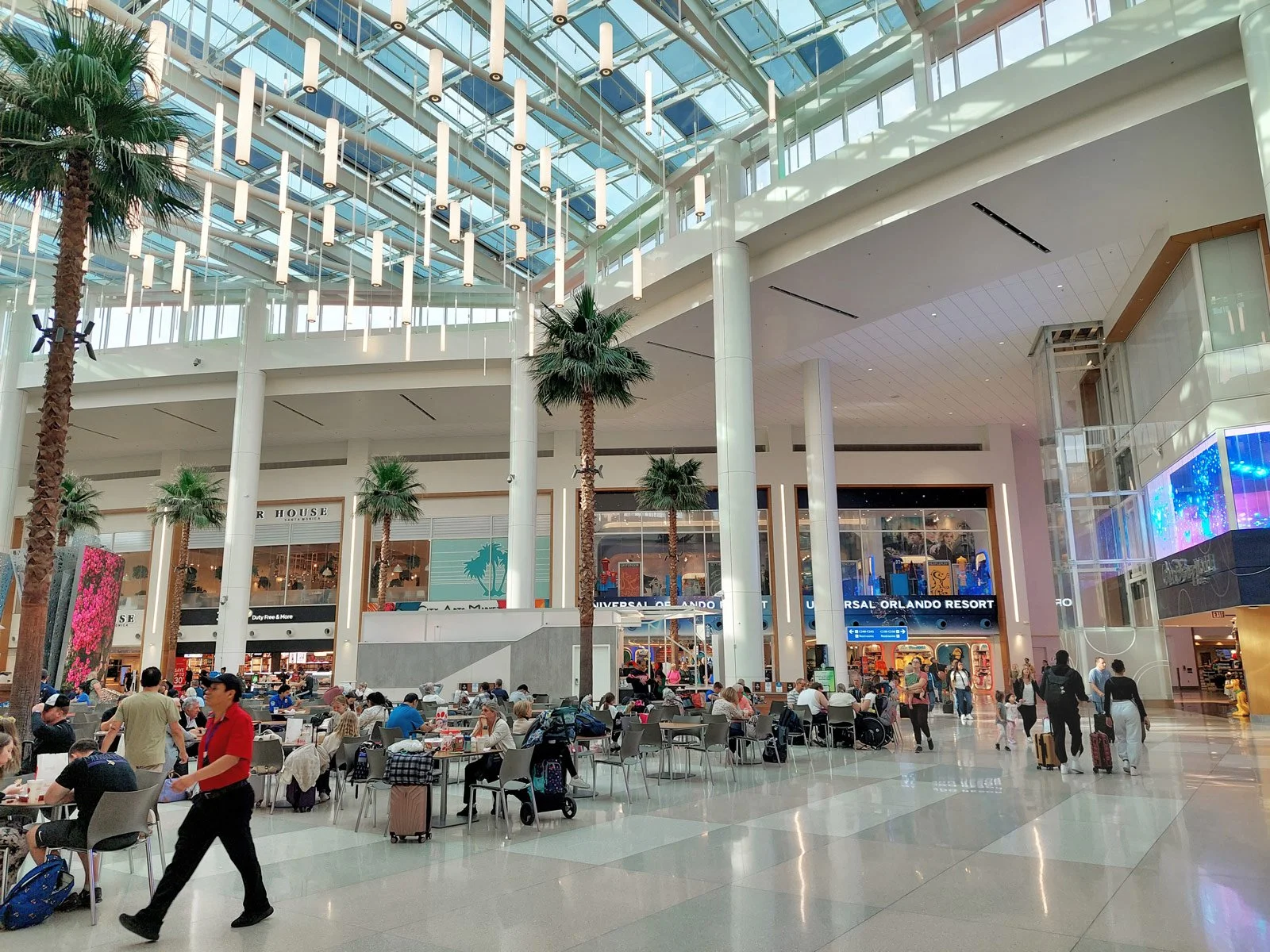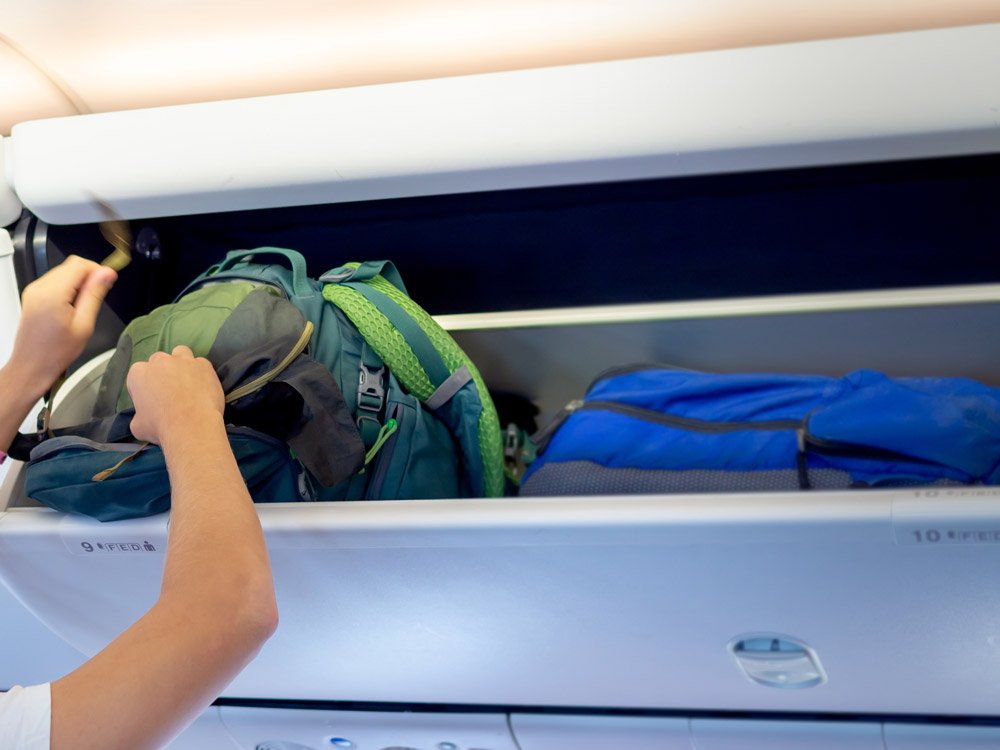7 tips to survive the Holiday Air Travel season
Passengers traverse the terminal at Washington Reagan National Airport during the holiday season.
Image: Evgenia Parajanian/Shutterstock.com
While the summer season is statistically the busiest overall period of year for the airline industry, winter months, particularly around the holidays, can be busier and more chaotic for the traveling public in a unique way.
Even though less people fly during winter than summer, flying during winter can be more stressful for two main reasons – peak travel days around the holidays, and good ole winter weather.
Why Winter Holiday Travel can be chaotic
Unlike summer, which brings a constant, evenly distributed stream of vacationing passengers, families, and kids out of school over the entire season, the specific days that holidays occur throughout winter concentrates air travel over just several days.
Peak travel days mean packed airplanes and airports
Airports see peak travel crowds in the days leading up to and following winter holidays such as Thanksgiving and Christmas.
Image: Sharkshock/Shutterstock.com
Essentially, airports and airlines see extreme spikes in passenger traffic over the holidays. This is because practically everyone is needing to fly on the same day(s) leading up to and following holidays such as Thanksgiving, Christmas, New Year’s Day, and many others that fall within this condensed window.
Proof is the statistics; for example, the day before Thanksgiving is historically one of the busiest travel days of the year for airports as people make their way across the country to be with family.
Winter weather delays
Winter snow storms, like this one in Denver, over the holidays can wreak havoc on air travel, causing delays, cancellations, and missed flights.
Image: The Window Flyer
The second major factor that can make holiday air travel stressful and chaotic is weather. Full airplanes and airports over the holidays, compounded with winter weather, blizzards, and snowstorms, is an inevitable recipe for delays, cancellations, and travel disruptions.
Many people – perhaps even yourself and your family – have experienced these situations first hand. Trust us when we say that, even for the most frequent seasoned flyers, impacted travel plans that strand you for hours, maybe even a night or two, are no fun for anyone. Not fun for passengers, not fun for the airline employees, and not fun for the flight crew.
Tips for flying and saving money over the winter holiday season
With that said, there are ways you can help make traveling and flying over the holidays and winter months easier, cheaper, and less stressful for yourself and your family.
In this article, we highlight a number of tips on how to make flying to grandma and grandpa’s house as relaxed and unstressful as possible, so that you can enjoy that holiday gathering with your siblings, grandparents, parents, aunts, uncles, and cousins.
Best of all, these holiday air travel tips are strategies that can be implemented entirely within your control, helping you be more empowered about how you travel.
1) Book and fly a nonstop flight to your destination
The main benefit of flying nonstop is to take connecting flights out of the equation. Flying nonstop eliminates layovers. When you have a nonstop ticket, there’s zero chance of missing your connecting flight and you’ll avoid the mad-dash sprint through the airport for a connecting flight that is already boarding.
Booking non-stop flights can help alleviate stressful moments due to missed connecting flights.
Image: fizkes/Shutterstock.com
In addition to reducing stress while flying, buying a nonstop flight for the holidays helps reduce your travel time since you’ll be flying directly to your destination. Quicker flights translates into maximizing your time with loved ones over the holiday season, which is the main goal, right? There’s also an environmental benefit of nonstop airline tickets, which lowers the carbon footprint of your air travel since your overall distance travelled is reduced.
The one caveat with nonstop flights is that they usually cost more than booking an airline ticket between the same cities with layovers. The higher airfare may be worth it though.
For one, you’ll have extra peace of mind that you’ll most likely make it to your destination on-time without much hassle. It can also be a financially-prudent decision when bad winter weather strikes. Airlines are not required to pay for your food and hotels if you miss a connecting flight due to weather. Winter weather can cause extreme delays, so paying a little extra for a non-stop flight can still be cheaper than having to shell out a couple hundred dollars for booking a hotel room near the airport if you get stranded overnight.
If you are a budget-conscious traveler, or you find the extra cost of non-stop airfare to be a challenge or burden, there are a number of strategies you can take to reduce your airfare cost, such as signing up for a credit card that gives good cash back for travel, purchasing discounted airline gift cards online, discounted airline gift cards at a warehouse club like Costco, or buying airline gift cards at your local grocery store.
2) don’t book flights with tight connections. Plan for layovers of at least two hours or more.
If there isn’t a nonstop flight available to your winter getaway or holiday destination, and you must book a flight with a layover don’t fret. While you might be tempted to book the most time-efficient itinerary with a short one-hour connection, it can be a gamble during winter.
Why are tight connections problematic during the winter and holiday travel season? To put it bluntly, tight connections leave no room for delays. Only so much time can be made up in the air, and if you had a 1-hour connection scheduled, but your first flight is delayed by just 30 minutes, you’ll have a tough time making your connecting flight.
While delays can happen any time of year for any number of reasons, readers in northern climates can relate to the saying “when it snows, everything slows.” When it snows, airports may need to temporarily close taxiways and runways for plowing, and every plane needs to be de-iced.
De-icing an aircraft during a snowstorm is a crucial and necessary procedure for safety, but can take 15 to 20 minutes, causing flight delays.
Image: The Window Flyer
A preflight de-ice procedure can easily add 15 to 20 minutes to your overall flight time, which eats into your layover time. Reduced visibility during a snowstorm might also force planes to take off and land with increased spacing, which inevitably causes more delays.
This tip of booking flights with longer layovers applies to everyone, not just travelers in Minnesota and Colorado. If you’re flying in state where it doesn’t snow, like California, Texas, or Florida, and think you may be spared from winter weather delays by the sun, think again.
Planes fly all over the country. You may be leaving San Deigo where it’s 70 degrees and sunny, with a layover in Houston, but your first flight might be delayed simply because your inbound aircraft took off an hour late from Denver where it was 20 degrees and snowing heavily. That can cause you to miss your tight connection in Houston.
Booking flights layovers of 2 or more hours, will help mitigate the risk of being stranded in an airport over the holidays.
3) Book connecting flights through major cities and airline hubs
Booking a flight with a layover in a major city, such as New York, as opposed to smaller airline hubs like Nashville or Portland, maximizes your chances of getting accommodated on a new flight in case of flight disruptions.
Image: The Window Flyer
Relating to the tip above, try and book your connecting flights through major cities like Seattle, San Francisco, Los Angeles, Phoenix, Denver, Dallas, Houston, Chicago, Minneapolis, Detroit, Atlanta, Miami, and New York.
This may seem counter-intuitive, and more chaotic. You might be thinking: shouldn’t I be trying to avoid crowds, not joining them?
Hear us out…
Big cities have big populations. The higher population has the inherent benefit of increased air travel demand, which increases the number of flight options to different destinations across the country. If you encounter a flight disruption flying during the holidays, there will be a higher number of alternative flight options to get you on your way to your final destination versus flying through a medium sized city like Portland, Salt Lake City, Nashville, Cincinnati, or Charlotte.
Connecting through a large city with multiple airline hubs can help get you on your way, with additional flight and connection options in the event of multiple delays and cancellations.
Image: William Barton/Shutterstock.com
Airports in big cities are also often home to major hub operations for airlines. Airline hubs have resources such as spare planes, increased staffing levels, and the ability to redispatch planes to different destinations to help mitigate delays. This helps keep an airline’s daily operation fine-tuned like a well-oiled machine, and helps get you to your destination on-time.
While some cities (such as Detroit are only home to one airline hub, Delta, in this case), most other major cities are home to multiple airline hubs. For example Seattle is an airline hub to both Alaska and Delta; Los Angeles to Alaska, American, Delta, and United; Chicago to American and United; and so forth.
Why is connecting through a city with multiple airline hubs advantageous for holiday travel? In the event of severely-disrupted travel plans, most airlines, with the notable exception of Southwest, have ticketing agreements with other carriers. This means that they have the opportunity to accommodate you on a different carrier if there are no other viable options on your original airline.
4) Book morning flights to avoid delays
Morning flights bring the least number of delays and can offer beautiful sunrises.
Image: The Window Flyer
The early bird gets the worm. When flying over the holidays, and any other time of year for that matter, morning flights are statistically the least delayed since airlines have an opportunity to “reset” their operations each and every night. First flights of the day are rarely delayed due to late-arriving inbound aircraft since most planes arrived to the airport the night before. The only exception to this is if your flight is scheduled on an aircraft that was flying a red-eye flight overnight.
By contrast, flights on any airline departing later in the afternoon and evening tend to be more delayed due to the cascading ripple effects that delays incrementally have on operations throughout a day. Once it plane is late, it’s going to continue being late for the rest of the day.
5) For the cheapest airfares, fly on the day of the actual holiday
It may not be practical, and may even defeat the whole purpose of flying for the holidays, but flying on the day of Thanksgiving, flying on Christmas Eve or Christmas Day, etc. will almost always get you a significantly cheaper airfare deal for the holidays.
For the best airfare deals, book your flight the day of the holiday. Notice how Christmas Day flights are significantly cheaper than just the couple days before and after. Expedia can be a good tool to compare airfare amongst airlines. (click to enlarge)
Image: Expedia.com
This is a more practical option for those who only have a short flight within the same time zone, like San Diego to Portland, as opposed to a cross-country flight from San Francisco to New York. If you don’t mind arriving to your family festivities a little bit late, you can save some serious money. Think about it this way, if you take a nonstop 7am flight the morning of Christmas, you can still get to your destination by about 9 or 10am and still enjoy the company of others for most of the day.
If you’re looking to book a last minute holiday air travel deal, using Expedia can be a good option as its search engine casts a wide net across multiple airlines and hotels to help you find the biggest discounts. In addition, being an online travel agent, Expedia lets you bundle flights, hotels, and rental cars into money-saving packages.
6) Don’t check a bag – carry it on
The day of your flight, try to avoid checking a bag if you can help it. When delays and missed connections happen, it adds the stress of wondering whether your bag will make it to your destination with you.
Checked baggage can become problematic during winter and holiday flight disruptions. Bags can end up being lost, unclaimed, or delayed.
Image: Elena Berd/Shutterstock.com
By simply carrying a bag as opposed to checking it in, you can be assured your bag will be within arm’s reach at all times. This can come in handy in a few winter travel scenarios.
If you encounter a severe travel delay that requires an overnight hotel stay, you’ll have a fresh set of clothes to change into the next morning.
If you aren’t stranded overnight, but you have been rebooked onto another flight, there’s no guarantee your checked bag will make it, especially if that rebooked flight leaves shortly. Even worse, if your rebooked flight is with a different carrier, you may need to go to bag claim, re-check your bag in with that airline, and go through airport security again. All this takes time and can severely limit your alternative flight options in the event of disrupted travel. If you just have a carry-on, you and your bag can easily walk over to the next gate and hop onto the next flight.
Do you tend to pack heavy? If you’re traveling with friends and family over the holidays, one strategy to “downsize” your bag is to see if you can share baggage space with your travel companions to ensure everyone in your reservation can get by with a carry-on bag only. You’re all headed to the same place anyway, right? Trust us, your clothes won’t mind being in someone else’s bag for a few hours.
If you’re looking for some carry-on luggage for your upcoming flight, here’s a couple cost-effective models that get the job done:
7) Dress in layers, but wait until after the TSA checkpoint to layer up
Winter travel brings the unique situation of needing to dress for the cold. All those extra sweaters, coats, beanies, and gloves can take up valuable space in your luggage.
One way to get around this is to wear those layers on the plane. In some extreme cases, passengers have been known to do this on ultra-low cost carriers to get around their carry-on bag fees.
But for most of the traveling public, wearing clothes in layers can be beneficial, as airplane cabins tend to be kept at a cooler temperature and can fluctuate through a flight. You can add a layer and take off a layer as needed in the airport and on the plane.
One tip we can offer to make this less stressful iis to wait until after the TSA checkpoint to put on those layers. Going through the TSA checkpoint can often be disorienting for passengers as they divest themselves of their belongings to put through the x-ray scanners.
Layers like coats and sweaters will need to go through the x-ray scanners. So to avoid the hassle of taking off all those layers while also trying to unload your shoes, liquids, and laptops, travelers should hand-carry extra clothing to the TSA checkpoint, and wait until after security to put on those layers. It’ll help speed up the airport screening process for yourself as well your fellow passengers in line behind you.
Bonus Tip: Pack that holiday spirit
Over-crowded airports, packed planes, and dreaded winter weather delays are stressful for many. You won’t be alone in your stress – chances are, other passengers, airport staff, and airline staff, have all had a long day dealing with disruptions as well. Kindness and positivity can go a long way not just yourself, but others as well.
Bottom Line
To recap, tips to survive a stressful holiday air travel season include booking non-stop flights, booking flights with longer connections, connecting in major cities, taking morning flights, and avoiding checking a bag. Money can also be saved by flying on the day of a holiday, as well as buying discounted airline gift cards.
These tips all have one thing in common – they are things you can control to help mitigate the risk and effects of travel delays and travel disruptions over the winter, which will help get you on your way to see friends and family over the holidays stress-free.
Safe travels!
Related Content

















